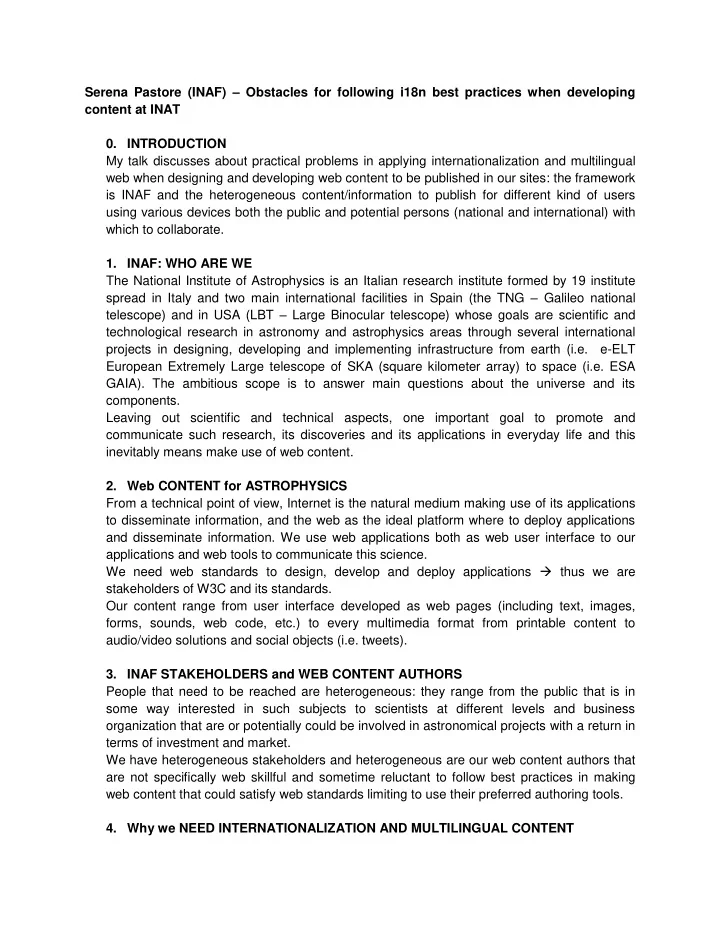

Serena Pastore (INAF) – Obstacles for following i18n best practices when developing content at INAT 0. INTRODUCTION My talk discusses about practical problems in applying internationalization and multilingual web when designing and developing web content to be published in our sites: the framework is INAF and the heterogeneous content/information to publish for different kind of users using various devices both the public and potential persons (national and international) with which to collaborate. 1. INAF: WHO ARE WE The National Institute of Astrophysics is an Italian research institute formed by 19 institute spread in Italy and two main international facilities in Spain (the TNG – Galileo national telescope) and in USA (LBT – Large Binocular telescope) whose goals are scientific and technological research in astronomy and astrophysics areas through several international projects in designing, developing and implementing infrastructure from earth (i.e. e-ELT European Extremely Large telescope of SKA (square kilometer array) to space (i.e. ESA GAIA). The ambitious scope is to answer main questions about the universe and its components. Leaving out scientific and technical aspects, one important goal to promote and communicate such research, its discoveries and its applications in everyday life and this inevitably means make use of web content. 2. Web CONTENT for ASTROPHYSICS From a technical point of view, Internet is the natural medium making use of its applications to disseminate information, and the web as the ideal platform where to deploy applications and disseminate information. We use web applications both as web user interface to our applications and web tools to communicate this science. We need web standards to design, develop and deploy applications thus we are stakeholders of W3C and its standards. Our content range from user interface developed as web pages (including text, images, forms, sounds, web code, etc.) to every multimedia format from printable content to audio/video solutions and social objects (i.e. tweets). 3. INAF STAKEHOLDERS and WEB CONTENT AUTHORS People that need to be reached are heterogeneous: they range from the public that is in some way interested in such subjects to scientists at different levels and business organization that are or potentially could be involved in astronomical projects with a return in terms of investment and market. We have heterogeneous stakeholders and heterogeneous are our web content authors that are not specifically web skillful and sometime reluctant to follow best practices in making web content that could satisfy web standards limiting to use their preferred authoring tools. 4. Why we NEED INTERNATIONALIZATION AND MULTILINGUAL CONTENT
By examining the context in which we work: all our stakeholder are international (coming from different countries) and thus multilingual. Modern science needs international collaboration and even if English is the common language, giving the possibility of information in the stakeholders native languages increases communication. We have to reach all our potential stakeholders to promote collaboration. But our situation (that is however common to many academic and research institutions) is: - Content and/or website in one language (Italian or English); - Authors use different authoring tools to create content from specific audio/video software makers (especially proprietary technology like Flash) to editors included in some CMS (each one with it authoring tools integrated i.e. Plone, Wordpress, Joomla); for audio/video content) used to publish documents and most yet are hand-make web pages; - Web content is hosted in several web servers: each institute composing INAF has its own website on its physical server and usually a variable number of servers hosting website of projects, researchers and so on. 5. OUR OBSTACLES We need to follow i18n principles (i.e. best practices) but our main obstacles is to educate authors to follow them and the fact that to follow i18n best practices an author should be skillful. This is in contrast in same way with the simplicity of publishing content on the web. The problem is that we have author get used to work with their authoring tools without taking attention to the source code. Best practices indicate to examine the code for example to verify declaration and implementation of encoding, but for our authors it is difficult to examine a source code or to customize software to make encoding choice. Moreover the use of CMS-like tools have changed the way in which web pages are developed making possible for everyone without specific skills to publish on the web, but the adherence to specification also in the internationalization field requires specific customization. If we analyze our web content, we notice that our authors still make little use of style sheet and do not restrict markup to semantics. 6. WHAT we need As INAF we have to educate and persuade our content authors that following web standards and best practices in developing web content will give a value-added to the content (reaching internationalization, accessibility, usability goals will help them to disseminate their research). However since the difficulty in following changes in web technologies and in the w3c specifications, we have to produce a document in order to fix the main steps to follow to produce in specific multilingual content trying to be as simple as possible. From authoring makers we hope there will be a new generation of tools able to create automatically multilingual and international content. 7. TO CONCLUDE The two main questions that summarize my talk were: o what could be the best way to produce multilingual web content to communicate astrophysical science and projects; o how we could educate and persuade our creators to follow internationalization while
using their preferred web authoring tools or web content management systems. A possible answer is that we should have authoring tools enabling the automatically generation of good content, however we have to do a great work in convincing our authors to follow web standards persuading them that such effort is useful and the only way to disseminate an information that could reach every stakeholder.
Recommend
More recommend